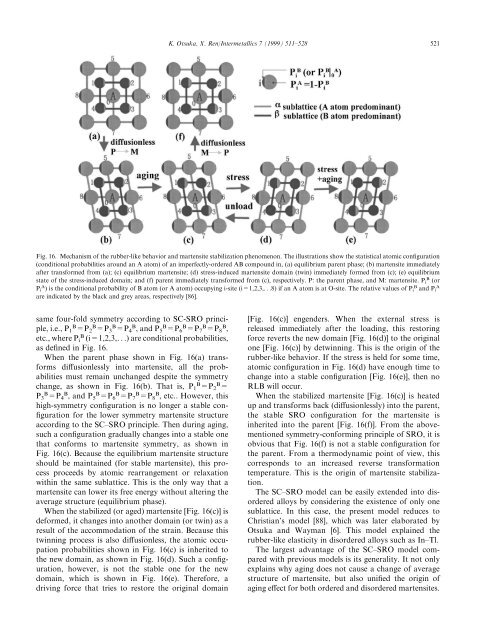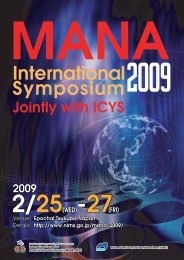Recent developments in the research of shape memory alloys
Recent developments in the research of shape memory alloys
Recent developments in the research of shape memory alloys
- No tags were found...
You also want an ePaper? Increase the reach of your titles
YUMPU automatically turns print PDFs into web optimized ePapers that Google loves.
K. Otsuka, X. Ren/Intermetallics 7 (1999) 511±528 521Fig. 16. Mechanism <strong>of</strong> <strong>the</strong> rubber-like behavior and martensite stabilization phenomenon. The illustrations show <strong>the</strong> statistical atomic con®guration(conditional probabilities around an A atom) <strong>of</strong> an imperfectly-ordered AB compound <strong>in</strong>, (a) equilibrium parent phase; (b) martensite immediatelyafter transformed from (a); (c) equilibrium martensite; (d) stress-<strong>in</strong>duced martensite doma<strong>in</strong> (tw<strong>in</strong>) immediately formed from (c); (e) equilibriumstate <strong>of</strong> <strong>the</strong> stress-<strong>in</strong>duced doma<strong>in</strong>; and (f) parent immediately transformed from (c), respectively. P: <strong>the</strong> parent phase, and M: martensite. P i B (orP i A ) is <strong>the</strong> conditional probability <strong>of</strong> B atom (or A atom) occupy<strong>in</strong>g i-site (i=1,2,3,...8) if an A atom is at O-site. The relative values <strong>of</strong> P i B and P iAare <strong>in</strong>dicated by <strong>the</strong> black and grey areas, respectively [86].same four-fold symmetry accord<strong>in</strong>g to SC-SRO pr<strong>in</strong>ciple,i.e., P 1 B =P 2 B =P 3 B =P 4 B , and P 5 B =P 6 B =P 7 B =P 8 B ,etc., where P i B (i=1,2,3,...) are conditional probabilities,as de®ned <strong>in</strong> Fig. 16.When <strong>the</strong> parent phase shown <strong>in</strong> Fig. 16(a) transformsdi€usionlessly <strong>in</strong>to martensite, all <strong>the</strong> probabilitiesmust rema<strong>in</strong> unchanged despite <strong>the</strong> symmetrychange, as shown <strong>in</strong> Fig. 16(b). That is, P 1 B =P 2 B =P 3 B =P 4 B , and P 5 B =P 6 B =P 7 B =P 8 B , etc.. However, thishigh-symmetry con®guration is no longer a stable con-®guration for <strong>the</strong> lower symmetry martensite structureaccord<strong>in</strong>g to <strong>the</strong> SC±SRO pr<strong>in</strong>ciple. Then dur<strong>in</strong>g ag<strong>in</strong>g,such a con®guration gradually changes <strong>in</strong>to a stable onethat conforms to martensite symmetry, as shown <strong>in</strong>Fig. 16(c). Because <strong>the</strong> equilibrium martensite structureshould be ma<strong>in</strong>ta<strong>in</strong>ed (for stable martensite), this processproceeds by atomic rearrangement or relaxationwith<strong>in</strong> <strong>the</strong> same sublattice. This is <strong>the</strong> only way that amartensite can lower its free energy without alter<strong>in</strong>g <strong>the</strong>average structure (equilibrium phase).When <strong>the</strong> stabilized (or aged) martensite [Fig. 16(c)] isdeformed, it changes <strong>in</strong>to ano<strong>the</strong>r doma<strong>in</strong> (or tw<strong>in</strong>) as aresult <strong>of</strong> <strong>the</strong> accommodation <strong>of</strong> <strong>the</strong> stra<strong>in</strong>. Because thistw<strong>in</strong>n<strong>in</strong>g process is also di€usionless, <strong>the</strong> atomic occupationprobabilities shown <strong>in</strong> Fig. 16(c) is <strong>in</strong>herited to<strong>the</strong> new doma<strong>in</strong>, as shown <strong>in</strong> Fig. 16(d). Such a con®guration,however, is not <strong>the</strong> stable one for <strong>the</strong> newdoma<strong>in</strong>, which is shown <strong>in</strong> Fig. 16(e). Therefore, adriv<strong>in</strong>g force that tries to restore <strong>the</strong> orig<strong>in</strong>al doma<strong>in</strong>[Fig. 16(c)] engenders. When <strong>the</strong> external stress isreleased immediately after <strong>the</strong> load<strong>in</strong>g, this restor<strong>in</strong>gforce reverts <strong>the</strong> new doma<strong>in</strong> [Fig. 16(d)] to <strong>the</strong> orig<strong>in</strong>alone [Fig. 16(c)] by detw<strong>in</strong>n<strong>in</strong>g. This is <strong>the</strong> orig<strong>in</strong> <strong>of</strong> <strong>the</strong>rubber-like behavior. If <strong>the</strong> stress is held for some time,atomic con®guration <strong>in</strong> Fig. 16(d) have enough time tochange <strong>in</strong>to a stable con®guration [Fig. 16(e)], <strong>the</strong>n noRLB will occur.When <strong>the</strong> stabilized martensite [Fig. 16(c)] is heatedup and transforms back (di€usionlessly) <strong>in</strong>to <strong>the</strong> parent,<strong>the</strong> stable SRO con®guration for <strong>the</strong> martensite is<strong>in</strong>herited <strong>in</strong>to <strong>the</strong> parent [Fig. 16(f)]. From <strong>the</strong> abovementionedsymmetry-conform<strong>in</strong>g pr<strong>in</strong>ciple <strong>of</strong> SRO, it isobvious that Fig. 16(f) is not a stable con®guration for<strong>the</strong> parent. From a <strong>the</strong>rmodynamic po<strong>in</strong>t <strong>of</strong> view, thiscorresponds to an <strong>in</strong>creased reverse transformationtemperature. This is <strong>the</strong> orig<strong>in</strong> <strong>of</strong> martensite stabilization.The SC±SRO model can be easily extended <strong>in</strong>to disordered<strong>alloys</strong> by consider<strong>in</strong>g <strong>the</strong> existence <strong>of</strong> only onesublattice. In this case, <strong>the</strong> present model reduces toChristian's model [88], which was later elaborated byOtsuka and Wayman [6]. This model expla<strong>in</strong>ed <strong>the</strong>rubber-like elasticity <strong>in</strong> disordered <strong>alloys</strong> such as In±Tl.The largest advantage <strong>of</strong> <strong>the</strong> SC±SRO model comparedwith previous models is its generality. It not onlyexpla<strong>in</strong>s why ag<strong>in</strong>g does not cause a change <strong>of</strong> averagestructure <strong>of</strong> martensite, but also uni®ed <strong>the</strong> orig<strong>in</strong> <strong>of</strong>ag<strong>in</strong>g e€ect for both ordered and disordered martensites.















